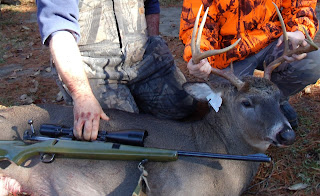While handling a gun or firearm, safety is of top importance. In our state, with the legalization of air guns for hunting, I use the term gun instead of firearm because an air gun should be treated as any other hunting implement in the area of safety concerns. Most accidents are due to careless and unsafe gun handling within a group of hunters known to each other. So especially while in your hunting group, practice these safety rules without exception.
 |
| (even in photo sessions, notice the open action, unloaded rifle and muzzle directed in safe direction - think safety first) |
1. Always be aware of where the muzzle of your gun is directed. Keep the muzzle in a safe direction. Never
pass it across the group or an individual within the group.
2. All guns are to be treated as if they are loaded. It doesn’t matter if you are 100% positive it is unloaded.
Still treat the gun as if it has a load in the chamber.
3. Unload all guns if not in immediate use. Unload, case and store guns when you are not using them. It is a
good idea to leave the action open, thereby giving an immediate visual as to it’s state with just a
glance.
4. While in the field. Regularly check of the condition of your gun barrel. Unload and make sure there is
no obstruction in the barrel, especially following a period when you may have been sitting on the
ground or anytime you may have set the gun down on the ground.
5. Keep your finger off the trigger and out of the trigger guard. Unless you actually plan to shoot at that
instant, do not keep your finger any place near the trigger. Do not depend fully on the guns mechanical safety, they have been known to fail. Many have squeezed a trigger without even knowing they were doing so, causing an unsafe discharge of the gun.
6. Know exactly what your target is and what is beyond the target. It is your responsibility to know not only
what you are shooting at, but what is around the target and in the path of the bullet. Even if a bullet
should pass through the target, as often happens, it may travel some distance before next contact.
You must know what is beyond your target and what is in the immediate vicinity.
7. Never point your gun at something you don’t intend to shoot. The scope on your rifle is not for spotting
game or identifying objects. Don’t allow any horseplay within your group.
8. Use extreme caution while moving around with a gun, especially a loaded gun in a hunting situation. Do
not climb fences or trees, run or jump or do any activity that might compromise the control of
where the muzzle is pointed at all times. Picking up a gun, do not pull the muzzle toward yourself,
always pick it up by the butt stock with the muzzle facing in a safe direction away from you.
Unload the gun before climbing a fence or tree stand or crossing an obstacle.
9. The storage of guns and ammunition is extremely important. Safely store guns in locked cases or
cabinets, secure from prying eyes and inquisitive youngsters or those careless adults that might be around. Always store the ammunition away from and separate from the gun to minimize the chance of an accident in case the gun is discovered unattended by one of the above individuals.
10. Drugs and Alcohol do not mix with loaded guns. Never drink before shooting or during shooting. This
is a bad mixture. If you are taking certain behavioral medications, you should consider not handling guns or firearms while doing so. These are prescribed medications that have warnings on the package about operation of dangerous equipment.
If you practice these safety rules at all times, you will have many years of safe hunting and shooting, thereby greatly enjoying the experiences you have outdoors in pursuit of game. No game animal is worth the cost of a hunting accident due to careless gun handling. I believe the instruction in this area of safe gun handling is one of the most important successes of the hunter safety training programs. We have seen a decrease many years in hunting accidents, of the younger hunters going afield, by those who have done well in hunter training courses. I was a hunter safety trainer for over a decade and these safety rules were repeatedly drilled into the thinking of the young hunters. Following these rules minimizes any accidents and helps make our shooting sports one of the safest outdoor sports to engage in.
